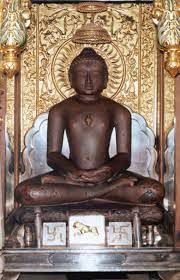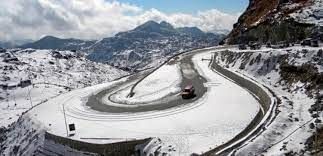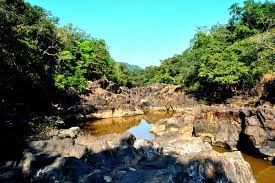UPSC Daily Current Affairs- 5th April 2023 | Current Affairs & Hindu Analysis: Daily, Weekly & Monthly PDF Download
GS-I
Jainism

Why in News?
Mahavir Jayanti was celebrated recently.
About Jainism:-
- The word Jain comes from the term Jina, meaning conqueror.
- According to Jain tradition, Mahavira was preceded by 23 Tirthankaras.
- The most important idea in Jainism is that the entire world is animated and even stones, rocks and water have life.
- According to Jain teachings, the cycle of birth and rebirth is shaped through karma and asceticism and penance are required to free oneself from the cycle of karma.
- This can be achieved only by renouncing the world.
- In order to do so, Jain monks and nuns had to take the five vows.
- Seven Tattvas (elements) of Jain Philosophy are:-
- Jiva: living substance
- Ajiva: matter or non-living substance
- Asrava: an influx of Karmic matter in the soul
- Bandha: bondage of soul by Karmic matter
- Samvara: stopping of Asrava
- Nirjara: gradual removal of Karmic matter
- Moksha: attainment of perfect freedom or salvation
Spread of Jainism:-
- Over hundreds of years, it spread to different parts of north India and to Gujarat, Tamil Nadu and Karnataka.
Literature:-
- Jain scholars produced a wealth of literature in a variety of languages namely Prakrit, Sanskrit and Tamil.
- Jain literature is classified into two major categories
- Agam Literature: This consists of original scriptures compiled by Ganadhars and Srut-Chehalis.
- They are written in the Prakrit language.
- Non-Agam Literature: This consists of commentary and explanation of Agam literature and independent works, compiled by elder monks, nuns, scholars, etc.
- These are written in many languages such as Prakrit, Sanskrit, Old Marathi, Gujarati, Hindi, Kannada, Tamil, German and English.
About Lord Mahavira:-
- Mahavira was born in the village Kundgrama near Vaishali in Bihar.
- His father Siddhartha was the head of the jnathrika Kshatriya clan under Vajji of Vaishali
- His mother Trishala was the sister of Chetaka, the king of Vaishali.
- Mahavira was also related to Bimbisara, the ruler of Magadha.
- Mahavira was married to Yashoda.
- He had a daughter Anonja Priyadarshini whose husband Jamali, became the first disciple of Mahavira.
- At the age of 30, after the death of his father, he renounced his family, became an ascetic and proceeded in search of truth.
- He was accompanied by Makkhali Gosala.
- Makkhali Gosala, later left him and founded the Ajivika sect.
- At the age of 42, under a sal tree at fab Jambhikagrama on the bank of river Rijupalika, Mahavira attained Kaivalya (supreme knowledge).
- He was called:-
- Kevalin: perfect learned
- Jina or Jitendriya: one who conquered his senses
- Nrigrantha: free from all bonds
- Arhant: the blessed one
- Mahavira: the brave and
- His followers were named Jain.
- He delivered his first sermon at Pava to his 11 disciples.
- Later, he founded a Jain Sangha (Jain commune) at Pava.
- At the Age of 72 in 468 BC, he passed away at Pavapuri near Biharsharif in Bihar.
Principles of Jainism as Preached by Mahavira:-
- Rejected the authority of the Vedas and Vedic rituals
- Did not believe in the existence of God.
- Believed in Karma and the transmigration of the soul
- Laid great emphasis on equality.
Source: The Hindu
Key Facts about Nathu La Pass

Why in News?
A massive avalanche recently struck the popular Nathu La mountain pass in Sikkim, trapping several tourists.
About Nathu La Pass:
- Location: It is a mountain pass in the Himalayas in the East Sikkim district.
- Altitude: It is situated at an altitude of 4302 m and is one of the highest motorable roads in the world.
- Nathu means "listening ears", and La means "pass" in Tibetan. It forms a part of an offshoot of the ancient Silk Road.
- Nathu La connects the Indian state of Sikkim with China's Tibet Autonomous Region.
- It is guarded on both sides by Chinese and Indian soldiers.
- Nathu La is one of the three open trading border posts between India and China; the other two are in Himachal Pradesh (Shipkila) and Uttarakhand (Lipulekh).
- Sealed by India after the 1962 Sino-Indian War, Nathu La was re-opened in 2006 following numerous bilateral trade agreements.
Source: The Hindu
GS-II
Organisation of Islamic Cooperation (OIC)
 '
'
Why in News?
The Indian Government slammed OIC for its comments on the Ram Navami violence recently.
About the Organisation of Islamic Cooperation (OIC):-
- It was established upon a decision of the historical summit which took place in Rabat, Kingdom of Morocco in 1969.
- Headquarters: Jeddah, Saudi Arabia.
- It is the second largest intergovernmental organization after the United Nations (UN).
- It has a membership of 57 states.
- Objectives:-
- It is the collective voice of the Muslim world.
- It endeavours to safeguard and protect the interests of the Muslim world.
- It aims to promote international peace and harmony among various people of the world.
- India is not a member of the OIC.
Source: The Hindu
What is Lokpal?

Why in News?
Lokpal’s office recently informed that Around 68% of corruption complaints against public functionaries that landed with the Lokpal were “disposed off” without any action in the past four years.
About Lokpal:
- The Lokpal is a statutory body established under the Lokpal and Lokayuktas Act 2013.
- Mandate: To inquire into allegations of corruption against certain public functionaries and for related matters.
- Organisational Structure:
- The Lokpal will consist of a chairperson and a maximum of eight members.
- Chairperson should be either the former Chief Justice of India Or the former Judge of the Supreme Court, or an eminent person who fulfils eligibility criteria as specified.
- Out of the maximum eight members, half will be judicial members. The judicial member of the Lokpal should be either a former Judge of the Supreme Court or a former Chief Justice of a High Court.
- Minimum fifty per cent of the Members will be from SC / ST / OBC / Minorities and women.
- How are members appointed?
- The Chairperson and the Members are appointed by the President of India on the recommendation of a selection committee composed of the Prime Minister as the Chairperson, the Speaker of Lok Sabha, the Leader of Opposition in Lok Sabha, the Chief Justice of India or a Judge nominated by him/her, and One eminent jurist.
- They hold office for a term of five years from the date on which they enter upon the office or until they attain the age of 70 years, whichever is earlier.
- The salary, allowances and other conditions of services of the Chairperson are the same as that of the Chief Justice of India.
- The salary, allowances and other conditions of services of the Members are the same as that of a Judge of the Supreme Court.
- Jurisdiction:
- It has jurisdiction to inquire into allegations of corruption against anyone who is or has been Prime Minister, or a Minister in the Union government, or a Member of Parliament, as well as officials of the Union Government under Groups A, B, C and D.
- It covers chairpersons, members, officers and directors of any board, corporation, society, trust or autonomous body either established by an Act of Parliament or wholly or partly funded by the Union or State government.
- It also covers any society or trust or body that receives foreign contribution above Rs 10 lakh.
- Exceptions for Prime Minister:
- Lokpal cannot inquire allegations against the PM relating to international relations, external and internal security, public order, atomic energy and space.
- Also, complaints against the PM are not to be probed unless the full Lokpal bench considers the initiation of inquiry and at least 2/3rds of the members approve it.
- Powers of Lokpal:
- It has powers to superintendence over and to give direction to CBI.
- If it has referred a case to CBI, the investigating officer in such case cannot be transferred without the approval of Lokpal.
- Powers to authorize CBI for search and seizure operations connected to such cases.
- The Inquiry Wing of the Lokpal has been vested with the powers of a civil court.
- Lokpal has powers of confiscation of assets, proceeds, receipts and benefits arisen or procured by means of corruption in special circumstances.
- Lokpal has the power to recommend the transfer or suspension of public servants connected with the allegation of corruption.
- Lokpal has the power to give directions to prevent the destruction of records during the preliminary inquiry.
Source: The Hindu
GS-III
Direct Taxes

Why in News?
Gross Direct Tax collections for the Financial Year 2022-23 registered a growth of over 20 per cent.
About Direct Taxes:-
- A direct tax is one that is levied directly on the taxpayer.
- It is paid directly to the government by those who are subjected to it.
- The Central Board of Direct Taxes is responsible for levying and collecting direct taxes as well as formulating other direct tax policies.
- Examples of Direct Tax: Income Tax, Corporation Tax, Minimum Alternate Tax, Capital Gain Tax etc.
Advantages of Direct Tax:-
- Economic Balance: The tax rate is set according to the country’s economic position.
- Ensures equality: Individuals and businesses with larger profits must pay higher taxes.
- Gives Certainty: The direct tax provides both the government and the taxpayers with a sense of certainty because the amount of tax that must be paid and collected is known to both the taxpayer and the government.
- During periods of high inflation, the government raises taxes in order to limit the demand for goods and services, resulting in a fall in inflation.
- It ensures that the government is held accountable.
Disadvantages of Direct Tax:-
- It can be easily evaded.
- Taxes are set arbitrarily by the Finance Minister if they are progressive.
- High taxes disincentivize people from saving and investing, causing the country’s economy to suffer.
- Paying direct taxes is quite inconvenient.
SOURCE: AIR
Project Tiger

Why in News?
Recently, Bandipur completed 50 years as Project Tiger Reserve.
About Project Tiger:-
- The Indira Gandhi government launched Project Tiger in 1973 from the Jim Corbett National Park in Uttarakhand.
- The tiger is a globally endangered species. India had a tiger population ranging from 20000 to 40000 at the turn of the twentieth century.
- A group of conservationists and researchers applied sustained pressure on the Indian government around 1970.
- As a result, the Wildlife Protection Act was drafted in 1972, effectively ending all hunting in India and legally protecting individual species.
- In 1973, Project Tiger was launched.
- Dr. Kailash Sankhla was named the first Director of Project Tiger in India.
About Bandipur Tiger Reserve:-
- It was established in 1973 under Project Tiger.
- In 1985, by including adjacent areas from Venugopala Wildlife Park, it was enlarged and named as Bandipur National Park.
- It is situated in two contiguous districts (Mysore and Chamarajanagar) of Karnataka.
- It is located in the tri-junction area of the States of Karnataka, Tamil Nadu and Kerala.
- It forms a part of the Nilgiri Biosphere Reserve.
- It lies in one of the richest biodiversity areas of the country.
- It is surrounded by
- Mudumalai Tiger Reserve (Tamil Nadu) in the South,
- Wayanad Wildlife Sanctuary (Kerala) in the South-west &
- The Kabini Reservoir separates the Bandipur and Nagarahole Tiger Reserve on the North-west.
- The park is located between the Kabini River in the north and the Moyar River in the south.
- The Nugu River runs through the park.
- The highest point in the park is on a hill called Himavad Gopalaswamy Betta.
SOURCE: THE HINDU
Netravali Wildlife Sanctuary

Why in News?
A black panther recently rescued from a village in Goa is healthy and it will be released into the Netravali Wildlife Sanctuary.
About Netravali Wildlife Sanctuary:
- It is situated in the Sanguem Taluka in Eastern Goa.
- River Netravali or Neturli originates in this sanctuary which is an important tributary of the Zuari River.
- To the north of the Netravali wildlife sanctuary lie the Bhagwan Mahavir Wildlife Sanctuary and the Cotigao Wildlife Sanctuary lies to its
- It has two all-season waterfalls, namely Savri and Mainapi.
- Flora: The forest is a predominantly moist deciduous type with patches of semi-evergreen forest in the valleys. The high-altitude areas in the hills have natural grassy patches that provide ideal habitat for the herbivorous population.
- Fauna: Indian gaur, spotted deer, sambar deer, barking deer, wild boar, and black-faced langur. the Great Pied Hornbills, Black Panther, Slender Loris and the Giant Squirrel.
Source: The Print
|
38 videos|5293 docs|1118 tests
|
FAQs on UPSC Daily Current Affairs- 5th April 2023 - Current Affairs & Hindu Analysis: Daily, Weekly & Monthly
| 1. What are the three general studies papers in the UPSC exam? |  |
| 2. What is the significance of GS-I in the UPSC exam? |  |
| 3. What is the coverage of GS-II in the UPSC exam? |  |
| 4. What subjects are included in GS-III of the UPSC exam? |  |
| 5. How can one prepare effectively for the GS papers in the UPSC exam? |  |
















